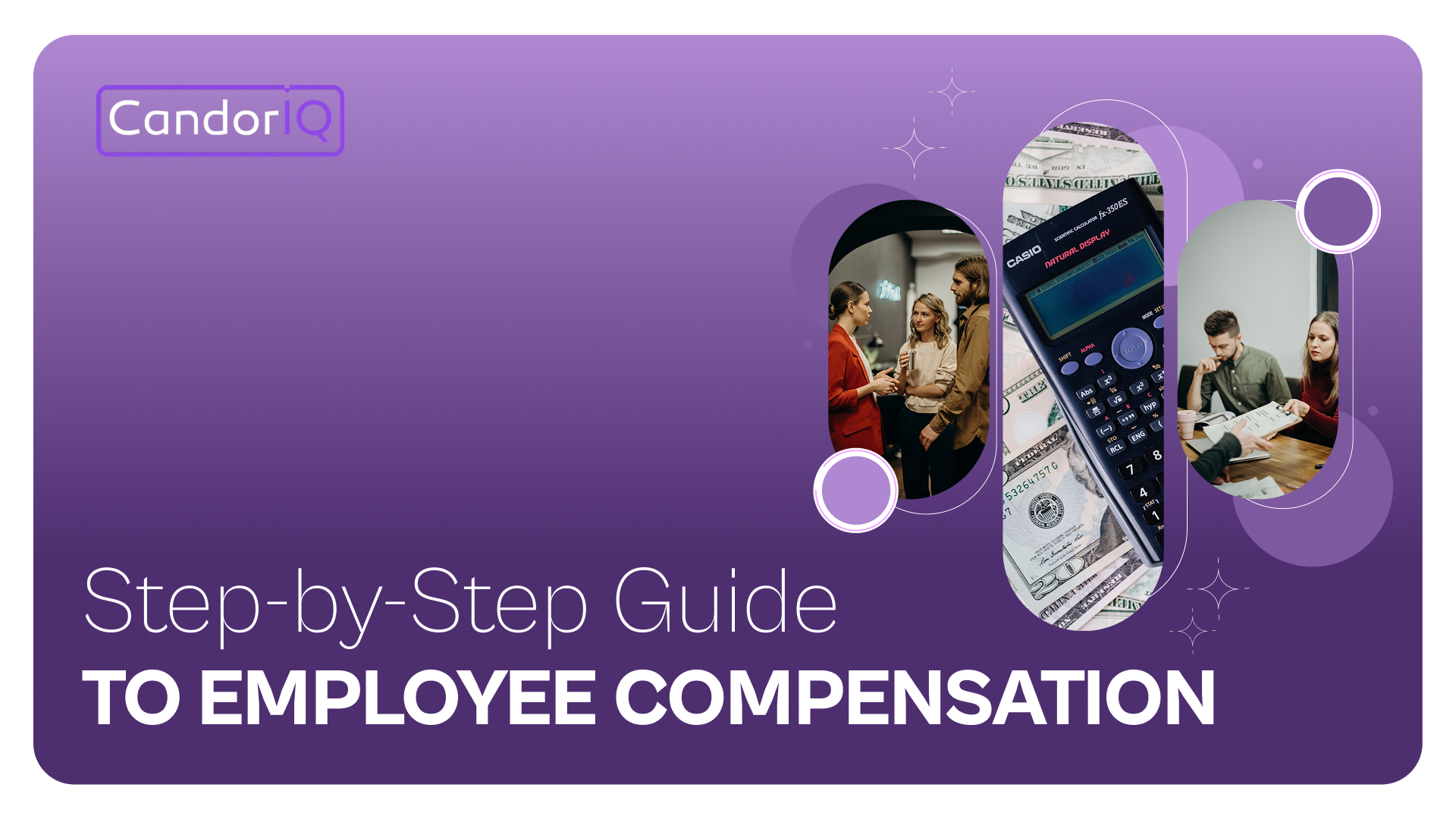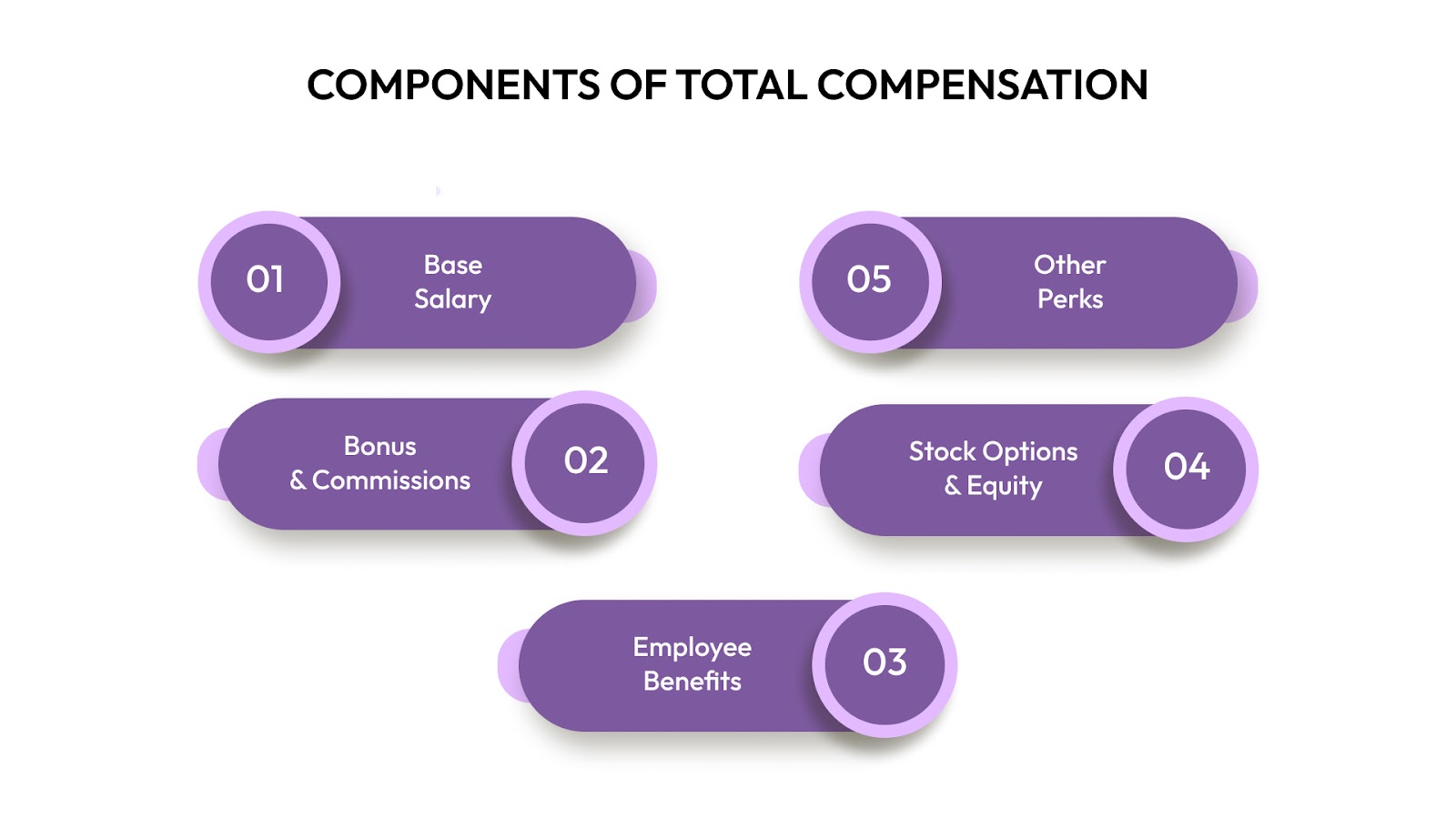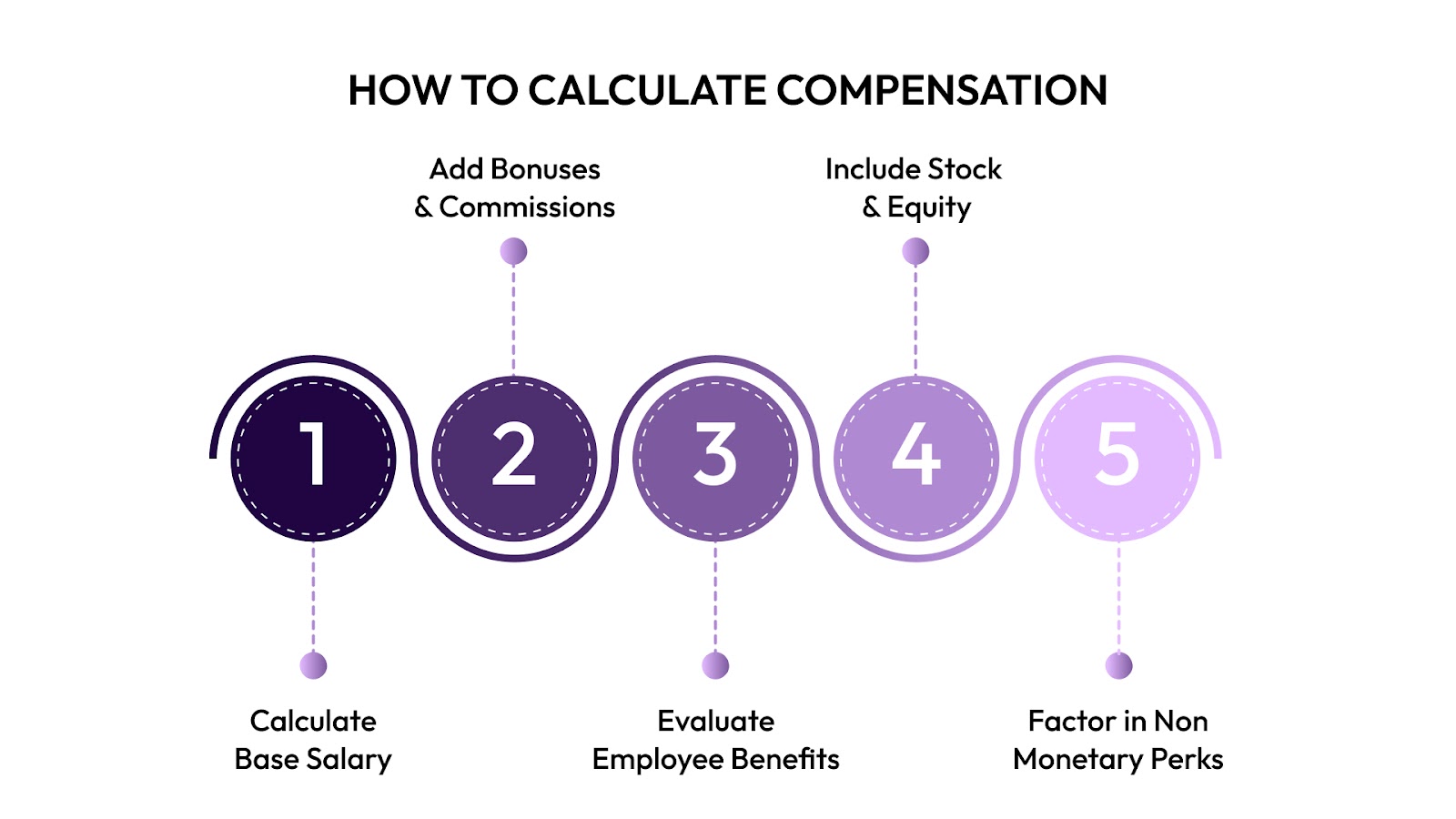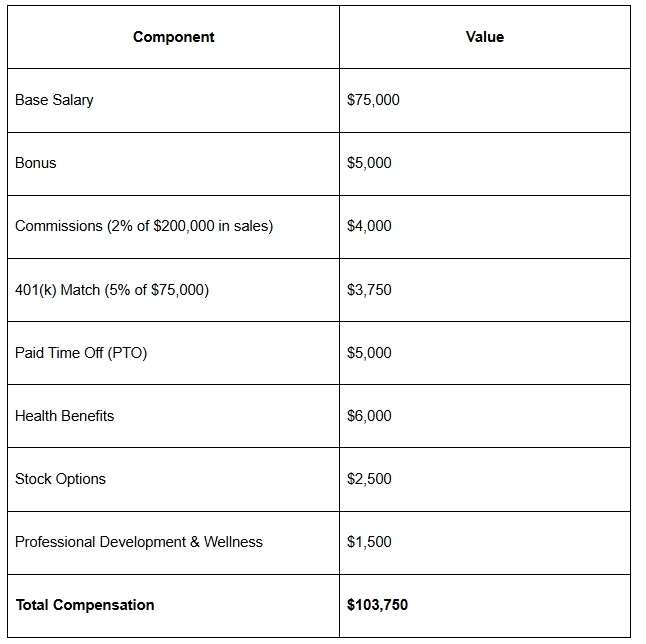How to Calculate Total Employee Compensation: A Step-by-Step Guide
Calculate total employee compensation by determining base salary, assessing health insurance, PTO, and adding variable pay. Start now!

Compensation is the top challenge for HR leaders, CPOs, and finance teams, and why shouldn't it be? 44% of employers report that compensation is their primary concern.
Calculating total compensation with varying pay structures and employee benefits is hard. However, if you get it right, you ensure fairness, transparency, and competitive advantage.
So, we’ve created a guide to simplify how to calculate compensation. We’ll follow each component step by step, giving you a clear framework to calculate total compensation that aligns with your business.
TL;DR
- Total compensation goes beyond base salary to include bonuses, commissions, employee benefits (like health insurance and retirement contributions), and stock options.
- Base salary is the foundation, but it's just one part of the overall package employees receive.
- Bonuses and commissions are performance-based rewards that can significantly increase an employee’s total pay.
- Employee benefits, including paid time off (PTO) and wellness programs, add tangible value to compensation packages.
- A clear understanding of total compensation is essential for pay equity, employee satisfaction, and effective workforce management.
What Is Total Employee Compensation?
Total compensation is the full range of financial and non-financial rewards an employee receives in exchange for their work. It includes base salary, bonuses, employee benefits (like health insurance and retirement contributions), stock options, and additional perks such as paid time off (PTO) and wellness programs.
Total compensation is not limited to salary alone. It also includes the value of benefits and perks, which together form the complete package that employees receive.
Now, let’s analyze each part of the package to understand its role in the overall compensation structure.
Components of Total Compensation

Total compensation is made up of several key components that together form the complete rewards package an employee receives. Let’s break down each part to understand how they contribute to the total value of a role.
1. Base Salary
Base salary is the foundation of total compensation, representing the fixed amount of money paid to an employee for their role.
- Definition: The fixed amount of money paid to an employee, either annually or on an hourly basis.
- Calculation: Base salary should reflect market trends, experience, and industry standards. It also varies based on location and company budget.
2. Bonus & Commissions
In addition to base salary, bonuses and commissions provide performance-based rewards that motivate employees and reward success.
- Definition: Additional financial rewards provided based on individual or company performance, sales targets, or profitability.
- Types:
- Performance bonuses: Paid for meeting or exceeding set goals.
- Signing bonuses: Given to new hires, often for key roles or challenging hires.
- Profit-sharing: A portion of company profits given to employees based on their role or seniority.
- Holiday bonuses: Typically given at the end of the year as a gesture of goodwill.
3. Employee Benefits
Employee benefits play a significant role in overall compensation, providing security and enhancing well-being.
- Definition: Non-salary perks that can include health insurance, retirement contributions, paid time off (PTO), and more.
- How to Quantify: Benefits can be assigned a monetary value based on company contributions (e.g., the cost of healthcare premiums or the employer’s matching contributions to retirement plans).
4. Stock Options & Equity
Stock options or equity are often offered as part of a compensation package to employees in startups or senior positions, giving them a stake in the company’s success.
- Definition: Stock options or equity allow employees to buy company stock at a future date, often at a lower price than the market value. This gives employees a financial interest in the company’s growth.
- Types:
- Stock options: The right to purchase stock at a set price.
- Restricted Stock Units (RSUs): A grant of stock that vests over time or upon meeting performance goals.
- Performance shares: Shares awarded based on achieving company performance metrics.
5. Other Perks
Non-monetary perks contribute significantly to employee satisfaction, well-being, and engagement.
- Definition: Benefits that are not direct payments, such as gym memberships, wellness programs, and professional development opportunities.
With the components understood, let’s proceed to the next step: calculating total compensation.
How to Calculate Compensation?

Calculating total compensation involves breaking down the various components to ensure you capture all elements of the compensation package. Let’s walk through the key steps.
Step 1: Calculate Base Salary
Start with the employee’s base salary, which is usually the largest part of their compensation.
- How to Calculate: Multiply the hourly rate by the number of hours worked for hourly employees or use the annual salary figure for salaried employees.
- Example: For an employee with a base salary of $75,000, their total annual salary is $75,000, unless the role is hourly, in which case you would calculate the number of hours worked per year (e.g., 40 hours per week × 52 weeks × hourly wage).
Step 2: Add Bonuses & Commissions
Bonuses and commissions are performance-based rewards that need to be added to the total.
- How to Calculate: Factor in any performance-based pay, commissions, or incentive bonuses that the employee is eligible for based on performance metrics.
- Example: If the employee receives a performance bonus of $5,000 for exceeding sales goals, you would add $5,000 to the total compensation. If they also earn a commission of 2% on sales, and their total sales for the year were $200,000, the commission would be $4,000 ($200,000 × 0.02).
Step 3: Evaluate Employee Benefits
Employee benefits can significantly increase total compensation and should be valued accurately.
- How to Calculate: Quantify the value of health insurance, retirement contributions, paid time off (PTO), and any other employee benefits offered.
- Example: If the employer contributes $500 monthly to health insurance, the annual value of the benefit would be $6,000 ($500 × 12 months). For retirement contributions, if the employer matches 5% of the base salary, that’s $3,750 ($75,000 × 0.05).
Step 4: Include Stock Options & Equity
If stock options or equity are part of the compensation, include their potential value in the calculation.
- How to Calculate: Calculate the potential value of stock options or equity, taking into account vesting schedules and market value.
- Example: If the employee is granted stock options worth $10,000, and the options are set to vest over 4 years, you would consider the prorated value for each year. In this case, it would be $2,500 per year ($10,000 ÷ 4).
Step 5: Factor in Non-Monetary Perks
Non-monetary perks add value to compensation but can be harder to quantify.
- How to Calculate: Assign a monetary value to non-monetary perks such as gym memberships, wellness programs, and other benefits that contribute to the employee’s overall satisfaction and well-being.
- Example: If the employee receives a gym membership worth $500 per year or wellness program benefits totaling $1,000, you would add these values to the total compensation.
Sample Total Compensation Calculation
Here’s an example calculation for an employee with a base salary of $75,000.

Now, let’s see how understanding total compensation benefits for both employees and employers.
Why Learning How to Calculate Compensation Matters
Understanding total compensation is crucial for both employees and employers. It helps make informed decisions, ensures fairness, and improves overall satisfaction within the organization.
Benefits For Employees
Having a clear understanding of total compensation empowers employees to make better career decisions and feel valued in their roles. When employees are aware of the full value of their compensation package, it serves as a powerful tool for negotiation, allowing them to assess job offers, understand long-term benefits, and advocate for themselves.
Furthermore, knowing that their total compensation increases job satisfaction, as employees feel appreciated, enhances their engagement and motivation within the organization.
Benefits For Employers
For employers, understanding total compensation is critical in managing talent and ensuring fair pay practices. Offering competitive total compensation packages plays a vital role in attracting and retaining top talent in a highly competitive job market.
Additionally, maintaining pay equity and ensuring fairness in compensation practices fosters trust and improves employee relations. This helps reduce turnover and builds a positive organizational culture that supports long-term employee retention.
Next, we will see how the right solutions can make managing total compensation much easier and more efficient.
How CandorIQ Helps with Compensation Management
Managing total compensation across various roles and departments can be complex. CandorIQ simplifies this process for HRBPs and People Ops teams with solutions that simplify compensation, headcount planning, and retention.
Unified Platform
CandorIQ integrates all aspects of compensation management, from pay bands to headcount forecasting, into one unified system.
This reduces the need for multiple tools and spreadsheets, making it easier for teams to manage compensation, align workforce plans with budgets, and ensure consistency across departments.
Compensation & Payband Builder
CandorIQ’s Compensation & Payband Builder helps organizations create structured pay bands that align with market data and internal equity. The platform allows you to:
- Define pay bands by job level, department, and location
- Use benchmark datasets to apply location-based salary adjustments
- Visualize pay distribution across the workforce in real time. It reduces the time spent manually managing spreadsheets, ensuring pay equity and transparency while supporting consistent hiring and promotion decisions.
Let CandorIQ streamline your people spend management!
Smooth Integrations
CandorIQ smoothly integrates with your existing HRIS, ATS, and finance systems, ensuring that compensation data flows smoothly across platforms.
By connecting with tools like Workday, Gusto, and Lever, CandorIQ ensures that all your compensation data is aligned with your HR and financial systems, creating a more streamlined and accurate process.
Global & Local Compensation Management
With geo-adjusted compensation features, CandorIQ ensures that your compensation packages are competitive and fair, regardless of location. This makes it easier to manage pay variations based on regional market trends, ensuring consistency across global teams.
Our Results
CandorIQ has delivered measurable outcomes for companies using its platform, including:
- 50% reduction in hiring time
- 2.5x faster merit cycles
- $500k savings on headcount annually
CandorIQ simplifies compensation management, making it easier to stay competitive while maintaining efficiency.
Final Thoughts
Figuring out how to calculate compensation can be tough for HR and finance teams. With many different parts to manage, like salaries, bonuses, and benefits, it’s easy for things to get mixed up. CandorIQ makes this easier by bringing everything into one platform, helping your team stay organized and make fair decisions about pay.
Want to see how CandorIQ can help? Book a demo today!
FAQs
Q1. What is the difference between base salary and total compensation?
A1. Base salary is the fixed amount paid to an employee, while total compensation includes base salary plus bonuses, benefits, stock options, and other perks. Understanding how to calculate compensation helps employees assess the full value of their pay package.
Q2. How do benefits like health insurance and retirement contributions factor into total compensation?
A2. Benefits like health insurance and retirement contributions are essential when learning how to calculate compensation. These add significant value beyond the base salary, impacting the overall worth of an employee’s total pay package.
Q3. Why is it important for HR professionals to understand how to calculate compensation?
A3. HR professionals must understand how to calculate compensation accurately to ensure pay equity, manage budgets effectively, and align compensation with company goals. This knowledge helps in making fair and competitive offers.
Q4. How can companies ensure fairness when calculating compensation across different roles and locations?
A4. Companies can use pay bands and adjust for geographical variations to ensure fairness in how to calculate compensation. This ensures equity, especially when managing diverse roles and locations.
Q5. What tools can assist in calculating total compensation?
A5. Tools like compensation software and calculators make it easier to calculate compensation by automating the process, offering benchmarks, and visualizing total compensation for better decision-making.


